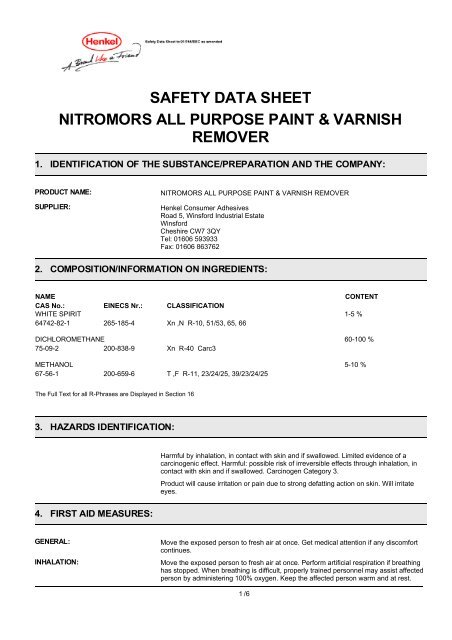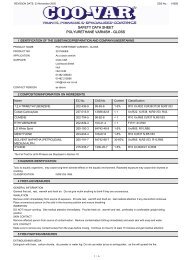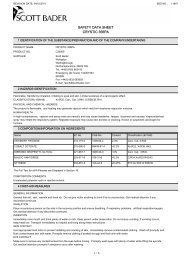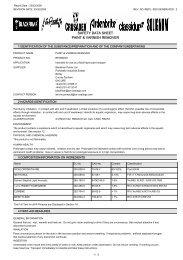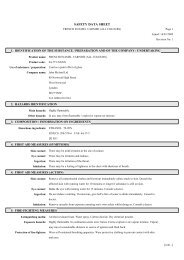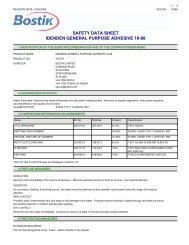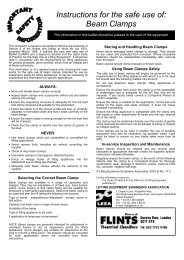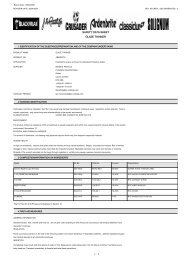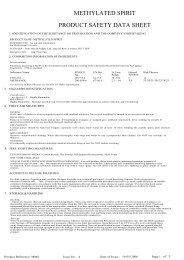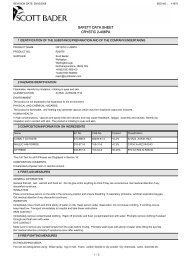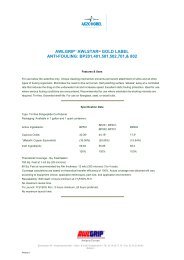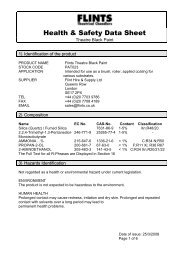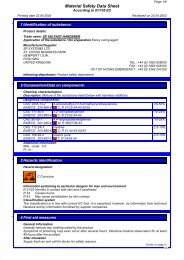safety data sheet nitromors all purpose paint & varnish remover
safety data sheet nitromors all purpose paint & varnish remover
safety data sheet nitromors all purpose paint & varnish remover
You also want an ePaper? Increase the reach of your titles
YUMPU automatically turns print PDFs into web optimized ePapers that Google loves.
SAFETY DATA SHEET<br />
NITROMORS ALL PURPOSE PAINT & VARNISH<br />
REMOVER<br />
1. IDENTIFICATION OF THE SUBSTANCE/PREPARATION AND THE COMPANY:<br />
PRODUCT NAME:<br />
SUPPLIER:<br />
NITROMORS ALL PURPOSE PAINT & VARNISH REMOVER<br />
Henkel Consumer Adhesives<br />
Road 5, Winsford Industrial Estate<br />
Winsford<br />
Cheshire CW7 3QY<br />
Tel: 01606 593933<br />
Fax: 01606 863762<br />
2. COMPOSITION/INFORMATION ON INGREDIENTS:<br />
NAME<br />
CAS No.:<br />
WHITE SPIRIT<br />
64742-82-1<br />
EINECS Nr.:<br />
CLASSIFICATION<br />
265-185-4 Xn ,N R-10, 51/53, 65, 66<br />
CONTENT<br />
1-5 %<br />
DICHLOROMETHANE<br />
75-09-2<br />
200-838-9 Xn R-40 Carc3<br />
60-100 %<br />
METHANOL<br />
67-56-1<br />
200-659-6 T ,F R-11, 23/24/25, 39/23/24/25<br />
5-10 %<br />
The Full Text for <strong>all</strong> R-Phrases are Displayed in Section 16<br />
3. HAZARDS IDENTIFICATION:<br />
Harmful by inhalation, in contact with skin and if sw<strong>all</strong>owed. Limited evidence of a<br />
carcinogenic effect. Harmful: possible risk of irreversible effects through inhalation, in<br />
contact with skin and if sw<strong>all</strong>owed. Carcinogen Category 3.<br />
Product will cause irritation or pain due to strong defatting action on skin. Will irritate<br />
eyes.<br />
4. FIRST AID MEASURES:<br />
GENERAL:<br />
INHALATION:<br />
Move the exposed person to fresh air at once. Get medical attention if any discomfort<br />
continues.<br />
Move the exposed person to fresh air at once. Perform artificial respiration if breathing<br />
has stopped. When breathing is difficult, properly trained personnel may assist affected<br />
person by administering 100% oxygen. Keep the affected person warm and at rest.<br />
1/6
12110 - NITROMORS ALL PURPOSE PAINT & VARNISH<br />
REMOVER<br />
Get prompt medical attention.<br />
INGESTION:<br />
SKIN:<br />
EYES:<br />
REVISION DATE:08-08-2002<br />
DO NOT INDUCE VOMITING! NEVER MAKE AN UNCONSCIOUS PERSON VOMIT<br />
OR DRINK FLUIDS! Remove victim immediately from source of exposure. Rinse mouth<br />
thoroughly. Provide rest, warmth and fresh air. Get medical attention immediately!<br />
Remove affected person from source of contamination. Remove contaminated clothing.<br />
Wash the skin immediately with soap and water. Get medical attention if irritation<br />
persists after washing.<br />
Make sure to remove any contact lenses from the eyes before rinsing. Promptly wash<br />
eyes with plenty of water while lifting the eye lids. Continue to rinse for at least 15<br />
minutes. Contact physician if irritation persists.<br />
5. FIRE FIGHTING MEASURES:<br />
EXTINGUISHING MEDIA:<br />
SPECIAL FIRE FIGHTING<br />
PROCEDURES:<br />
UNUSUAL FIRE & EXPLOSION<br />
HAZARDS:<br />
HAZARDOUS COMBUSTION<br />
PRODUCTS:<br />
Fire can be extinguished using: Water spray, fog or mist. Alcohol resistant foam.<br />
Carbon dioxide (CO2). Dry chemicals, sand, dolomite etc.<br />
Avoid breathing fire vapours. Use pressurized air mask if substance is involved in a fire.<br />
Cool containers exposed to flames with water until well after the fire is out. Keep run-off<br />
water out of sewers and water sources. Dike for water control. If risk of water pollution<br />
occurs, notify appropriate authorities.<br />
May develop highly toxic or corrosive fumes if heated. May form explosive or toxic<br />
mixtures with air.<br />
Acrid smoke/fumes of : Carbon dioxide (CO2). Carbon monoxide (CO). Hydrogen<br />
chloride (HCl). Phosgene (COCl2).<br />
6. ACCIDENTAL RELEASE MEASURES:<br />
SPILL CLEANUP METHODS:<br />
Extinguish <strong>all</strong> ignition sources. Avoid sparks, flames, heat and smoking. Ventilate.<br />
Provide ventilation and confine spill. Do not <strong>all</strong>ow runoff to sewer. Collect with<br />
absorbent, non-combustible material into suitable containers. Collect and reclaim or<br />
dispose in sealed containers in licensed waste. Clean-up personnel should use<br />
respiratory and/or liquid contact protection. In handling of spillage, please also consult<br />
the section detailing protective measures. Should be prevented from entering drains.<br />
Do not contaminate water sources or sewer. Inform Authorities if large amounts are<br />
involved.<br />
7. HANDLING AND STORAGE:<br />
USAGE PRECAUTIONS:<br />
STORAGE PRECAUTIONS:<br />
STORAGE CRITERIA:<br />
Avoid spilling, skin and eye contact. Keep away from heat, sparks and open flame.<br />
Ventilate well, avoid breathing vapours. Use approved respirator if air contamination is<br />
above accepted level. Use explosion proof electric equipment. Wear full protective<br />
clothing for prolonged exposure and/or high concentrations.<br />
Keep in cool, dry, ventilated storage and closed containers. Keep in original container.<br />
Keep away from heat, sparks and open flame. Handle and open with care: pressure<br />
may occur if the container is stored in warm conditions.<br />
Misc.hazardous material storage.<br />
8. EXPOSURE CONTROLS AND PERSONAL PROTECTION:<br />
INGREDIENT NAME: CAS No.: STD LT EXP 8 Hrs ST EXP 15 Min<br />
METHANOL<br />
67-56-1<br />
OES<br />
200 ppm(Sk) 250 ppm(Sk)<br />
DICHLOROMETHANE<br />
75-09-2<br />
MEL<br />
100 ppm 300 ppm<br />
2/6
12110 - NITROMORS ALL PURPOSE PAINT & VARNISH<br />
REMOVER<br />
INGREDIENT COMMENTS:<br />
PROTECTIVE EQUIPMENT:<br />
REVISION DATE:08-08-2002<br />
OES = Occupational Exposure Standard. MEL = Maximum Exposure Limit.<br />
VENTILATION:<br />
RESPIRATORS:<br />
PROTECTIVE GLOVES:<br />
EYE PROTECTION:<br />
OTHER PROTECTION:<br />
HYGIENIC WORK PRACTICES:<br />
All handling to take place in well ventilated area. Provide adequate general and local<br />
exhaust ventilation. Must not be handled in confined space without sufficient ventilation.<br />
Respiratory protection must be used if air concentration exceeds acceptable level. SA,<br />
Supplied-air respirator. SCBA, Self-contained breathing apparatus.<br />
Use protective gloves. For short term exposure Use protective gloves made of:<br />
Polyvinyl chloride (PVC). For longer term exposure wear North Silver Shield Gloves<br />
(break through time >8 hours).<br />
Use approved <strong>safety</strong> goggles or face shield.<br />
Wear appropriate clothing to prevent any possibility of liquid contact and repeated or<br />
prolonged vapour contact.<br />
DO NOT SMOKE IN WORK AREA! Wash at the end of each work shift and before<br />
eating, smoking and using the toilet. Wash promptly with soap & water if skin becomes<br />
contaminated. Promptly remove any clothing that becomes contaminated. Use<br />
appropriate skin cream to prevent drying of skin. No eating or drinking while working<br />
with this material.<br />
9. PHYSICAL AND CHEMICAL PROPERTIES:<br />
APPEARANCE:<br />
COLOUR:<br />
ODOUR/TASTE:<br />
BOILING POINT (°C, interval):<br />
DENSITY/SPECIFIC GRAVITY (g/ml):<br />
Mobile. Viscous. Liquid.<br />
Clear. to Milky.<br />
Sweet. Chlorinated hydrocarbons.<br />
~ 40 Pressure:<br />
~ 1.22 Temperature (°C): 20<br />
VAPOUR DENSITY (air=1): (dichloromethane) 2.93<br />
VAPOUR PRESSURE:<br />
VOLATILITY DESCRIPTION:<br />
EVAPORATION RATE:<br />
(dichloromethane) 380 mbar Temperature (°C): 20<br />
Volatile.<br />
12110 - NITROMORS ALL PURPOSE PAINT & VARNISH<br />
REMOVER<br />
STABILITY:<br />
CONDITIONS TO AVOID:<br />
REVISION DATE:08-08-2002<br />
Norm<strong>all</strong>y stable. Will decompose on red hot surfaces, in electric arcs or naked flames<br />
to evolve predominately hydrochloric acid and a trace of phosgene gas<br />
Avoid heat. Avoid contact with oxidisers or reducing agents.<br />
HAZARDOUS DECOMP.<br />
PRODUCTS:<br />
Fire creates: Toxic gases/vapours/fumes of: Carbon monoxide (CO). Phosgene<br />
(COCl2). Hydrogen chloride (HCl).<br />
11. TOXICOLOGICAL INFORMATION:<br />
TOXIC DOSE - LD 50:<br />
HEALTH WARNINGS:<br />
OTHER HEALTH EFFECTS:<br />
ROUTE OF ENTRY:<br />
TARGET ORGANS:<br />
MEDICAL SYMPTOMS:<br />
MEDICAL CONSIDERATIONS:<br />
(dichloromethane) 1600 mg/kg (oral rat)<br />
Gas or vapour is harmful on prolonged exposure or in high concentration. This<br />
chemical may cause skin/eye irritation. CNS depressant. INHALATION. Solvent<br />
vapours are hazardous and may cause nausea, sickness and headaches. May cause<br />
irritation to the respiratory system. Narcotic effect. SKIN CONTACT. Irritating to skin.<br />
Acts as a defatting agent on skin. May cause cracking of skin, and eczema. EYE<br />
CONTACT. Irritating to eyes. INGESTION. Sw<strong>all</strong>owing concentrated chemical may<br />
cause severe internal injury. Liver and/or kidney damage. Unconsciousness, death.<br />
IARC Int. Agency for Cancer Research. Consolidated carcinogen list. Carcinogen<br />
Category 3.<br />
Inhalation. Skin absorption. Ingestion. Skin and/or eye contact.<br />
Central nervous system. Eyes. Heart & cardiovascular system. Kidneys. Liver.<br />
Respiratory system, lungs. Skin.<br />
Extreme irritation of eyes and mucous membranes, including burning and tearing.<br />
Dilated pupils. Severe skin irritation. Nausea, vomiting. Unconsciousness, possibly<br />
death. Central nervous system depression. Drowsiness, dizziness, disorientation,<br />
vertigo. Behavioral changes. Hypotension (low blood pressure).<br />
Skin disorders and <strong>all</strong>ergies. Liver and/or kidney problems. Convulsive disorders, CNS<br />
problems. History of smoking.<br />
12. ECOLOGICAL INFORMATION:<br />
LC 50, 96 HRS, FISH mg/l:<br />
ECOLOGICAL INFORMATION:<br />
MOBILITY:<br />
BIO ACCUMULATION:<br />
DEGRADABILITY:<br />
193-330 (dichloromethane)<br />
Dangerous for the environment if discharged into watercourses.<br />
Will sink in aqueous systems. Slighly soluble in water Will evaporate from land spillage.<br />
Not expected to bioaccmulate.<br />
Slowly biodegradable in water. Slowly biodegradable in soil.<br />
13. DISPOSAL CONSIDERATIONS:<br />
DISPOSAL METHODS:<br />
Vent to atmosphere. Dispose of in accordance with Local Authority requirements. Do<br />
not <strong>all</strong>ow runoff to sewer, waterway or ground.<br />
4/6
12110 - NITROMORS ALL PURPOSE PAINT & VARNISH<br />
REMOVER<br />
REVISION DATE:08-08-2002<br />
14. TRANSPORT INFORMATION:<br />
LABEL FOR CONVEYANCE:<br />
UN No. ROAD: 2810<br />
UK ROAD TRANSPORT CLASS: 6.1<br />
UK ROAD PACK GR.:<br />
III<br />
ADR CLASS No.: 6.1<br />
ADR CLASS:<br />
ADR ITEM No.:<br />
HAZARD No. (ADR):<br />
PROPER SHIPPING NAME I:<br />
Division 6.1:Toxic substances.<br />
25(c)<br />
60 Toxic or slightly toxic substance.<br />
TOXIC LIQUID,ORGANIC NOS (Contains dichloromethane & methanol)<br />
RID CLASS No.: 6.1<br />
RID ITEM No.:<br />
25(c)<br />
UN No. SEA: 2810<br />
IMDG CLASS: 6.1<br />
IMDG PAGE No.: 136 (2000 Edition Volume 2)<br />
IMDG PACK GR.:<br />
III<br />
EmS No.: 6.1-02<br />
MARINE POLLUTANT:<br />
No.<br />
UN No., AIR: 2810<br />
ICAO CLASS: 6.1<br />
AIR PACK GR.:<br />
III<br />
15. REGULATORY INFORMATION:<br />
LABEL FOR SUPPLY:<br />
CONTAINS<br />
METHANOL<br />
DICHLOROMETHANE<br />
5/6
12110 - NITROMORS ALL PURPOSE PAINT & VARNISH<br />
REMOVER<br />
RISK PHRASES:<br />
SAFETY PHRASES:<br />
STATUTORY INSTRUMENTS:<br />
APPROVED CODE OF PRACTICE:<br />
REVISION DATE:08-08-2002<br />
R-20/21/22 Harmful by inhalation, in contact with skin and if sw<strong>all</strong>owed.<br />
R-40 Limited evidence of a carcinogenic effect.<br />
R-68/20/21/22 Harmful: possible risk of irreversible effects through inhalation, in<br />
contact with skin and if sw<strong>all</strong>owed.<br />
P-16 Can become highly flammable in use.<br />
S-13 Keep away from food, drink and animal feeding stuffs.<br />
S-18 Handle and open container with care.<br />
S-2 Keep out of reach of children.<br />
S-21 When using do not smoke.<br />
S-23A Do not breathe gas/fumes/vapour/spray.<br />
S-24/25 Avoid contact with skin and eyes.<br />
S-3/7/9 Keep container tightly closed, in a cool, well ventilated place.<br />
S-35 This material and its container must be disposed of in a safe way.<br />
S-36/37/39 Wear suitable protective clothing, gloves and eye/face protection.<br />
S-51 Use only in well ventilated areas.<br />
S-52 Not recommended for interior use on large surface areas.<br />
S-62 If sw<strong>all</strong>owed, do not induce vomiting. Seek medical advice immediately and show<br />
the container or label.<br />
Chemicals (Hazard Information and Packaging) Regulations. Control of Substances<br />
Hazardous to Health.<br />
Classification and Labelling of Substances and Preparations Dangerous for Supply.<br />
GUIDANCE NOTES:<br />
Occupational Exposure Limits EH40. Introduction to Local Exhaust Ventilation<br />
HS(G)37. CHIP for everyone HSG(108).<br />
16. OTHER INFORMATION:<br />
INFORMATION SOURCES:<br />
ISSUED BY:<br />
Material Safety Data Sheet, Misc. manufacturers. Dangerous Properties of Industrial<br />
Materials Report, N.Sax et.al.<br />
Technical Services Department, Winsford, Cheshire<br />
REVISION DATE: 08-08-2002<br />
R-PHRASES (Full Text):<br />
DISCLAIMER:<br />
R-11 Highly flammable. R-23/24/25 Toxic by inhalation, in contact with skin and if<br />
sw<strong>all</strong>owed. R-39/23/24/25 Toxic: danger of very serious irreversible effects through<br />
inhalation, in contact with skin and if sw<strong>all</strong>owed. R-10 Flammable. R-51/53 Toxic to<br />
aquatic organisms, may cause long-term adverse effects in the aquatic environment.<br />
R-65 Harmful: may cause lung damage if sw<strong>all</strong>owed. R-66 Repeated exposure may<br />
cause skin dryness or cracking. R-40 Limited evidence of a carcinogenic effect.<br />
Every effort has been made to ensure that this information is accurate and up to date.<br />
Users are reminded that they should ensure that they have retained or intern<strong>all</strong>y<br />
circulated the most up to date copy as provided to the persons or work locations which<br />
require them. No warranty is implied or given as to suitability for use for any activity<br />
which is not covered by either the technical <strong>data</strong> <strong>sheet</strong> or restrictions of use as above.<br />
6/6


